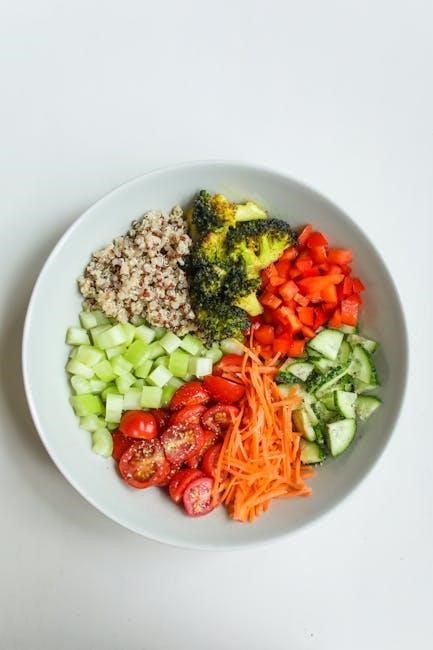Understanding the Low GI Diet

The glycemic index (GI) is a measure of how foods affect blood sugar levels. Low GI foods release glucose slowly, helping maintain stable energy and supporting weight management.
What is the Glycemic Index (GI)?
The glycemic index (GI) is a numerical scale that measures how quickly foods containing carbohydrates raise blood sugar levels after consumption. Ranked from 0 to 100, it helps identify which foods cause a rapid spike in glucose and which ones release sugar more gradually. Low GI foods (55 or below) are digested slowly, providing a steady increase in blood sugar, while high GI foods (70 or above) cause a sharp rise. This index is particularly useful for managing conditions like diabetes and supporting weight management. By understanding the GI of foods, individuals can make informed choices to balance their meals and maintain stable energy levels throughout the day. Incorporating low GI foods into your diet can help prevent energy crashes and promote overall metabolic health. This concept is central to the low GI diet plan, which focuses on sustainable eating habits rather than restrictive dieting.
How the GI Diet Works
The GI diet focuses on managing blood sugar levels by prioritizing low glycemic index (GI) foods. These foods release glucose slowly, preventing sharp spikes in blood sugar. By balancing meals with low GI options like whole grains, legumes, and non-starchy vegetables, the diet helps maintain stable energy levels. Unlike restrictive diets, the GI diet allows flexibility, as even high GI foods can be included when paired with low GI foods to balance the overall meal’s glycemic impact. This approach supports sustainable weight loss by reducing hunger and cravings. The diet emphasizes portion control and mindful eating, making it a practical long-term solution for improving metabolic health and managing conditions like diabetes. By focusing on food quality and balance rather than strict restrictions, the GI diet promotes a healthier relationship with eating and sustains energy throughout the day.

Benefits of a Low GI Diet
A low GI diet offers numerous health benefits, particularly for blood sugar management and weight control. By focusing on foods with a low glycemic index, the diet helps stabilize blood sugar levels, preventing rapid spikes and crashes. This can improve energy levels, reduce hunger, and support sustainable weight loss. The diet also promotes heart health by lowering cholesterol and triglycerides, and it may reduce the risk of chronic conditions like type 2 diabetes. Additionally, low GI foods are often rich in fiber, vitamins, and minerals, contributing to overall nutritional well-being. The gradual release of glucose ensures prolonged satisfaction, making it easier to stick to the diet long-term. Overall, the low GI diet is a balanced and flexible approach that supports metabolic health, energy stability, and improved eating habits without strict food restrictions.

Creating a Low GI Diet Plan
A low GI diet plan involves selecting foods with a glycemic index of 55 or less, such as whole grains, legumes, and non-starchy vegetables. It emphasizes balanced meals, portion control, and gradual glucose release for sustained energy and weight management.

Step-by-Step Guide to Developing a Personalized Plan
Creating a personalized low GI diet plan begins with identifying low GI foods like whole grains, legumes, and non-starchy vegetables. Assess your current diet to replace high GI foods with these alternatives. Set clear goals, whether for weight loss, blood sugar management, or energy levels. Plan balanced meals weekly, ensuring variety and nutrient-rich options. Practice portion control to avoid overeating, even with healthier choices; Track your progress through a food diary, noting how you feel and any measurable changes like weight or blood sugar levels. Stay consistent by keeping meals interesting with new recipes and meal prepping. Be flexible to adjust the plan as needed, addressing challenges like food accessibility or cooking for others. Regularly review and adapt your diet to ensure it remains effective and sustainable. By following these steps, you can tailor a low GI diet to meet your unique needs and lifestyle, promoting long-term health and well-being.

Sample 7-Day Low GI Meal Plan

A 7-day low GI meal plan focuses on balanced nutrition with low glycemic index foods. Day 1: scrambled eggs with spinach, whole-grain toast, and avocado for breakfast; grilled chicken salad with chickpeas and olive oil for lunch; baked salmon with quinoa and broccoli for dinner. Day 2: Greek yogurt with berries and almonds; turkey and avocado wrap with whole-grain tortilla; roasted chicken with sweet potato and green beans. Day 3: oatmeal with cinnamon and walnuts; lentil soup with a side of mixed greens; grilled shrimp with brown rice and asparagus. Day 4: smoothie with spinach, banana, and almond milk; grilled turkey with roasted vegetables; cod with cauliflower rice and Brussels sprouts. Days 5-7 follow a similar pattern, alternating proteins and vegetables. Snacks include nuts, apple slices, or carrot sticks with hummus. This plan ensures variety, nutrient balance, and sustained energy, adhering to low GI principles while avoiding high glycemic foods.
Low GI Shopping List and Grocery Tips
Stock your pantry with whole, unprocessed foods to support a low GI diet. Essential items include whole grains like brown rice, quinoa, and whole-grain bread, along with legumes such as lentils, chickpeas, and black beans. Incorporate non-starchy vegetables like broccoli, spinach, and bell peppers, and opt for low GI fruits like apples, berries, and citrus. Protein sources should include lean meats, fish, eggs, and tofu. Healthy fats like avocados, nuts, and olive oil are also key. When shopping, read labels to avoid added sugars and refined carbohydrates. Plan meals in advance to reduce impulse purchases. Aim for variety to ensure a broad nutrient intake. Avoid sugary snacks and opt for low GI alternatives like nuts or yogurt. This approach ensures your grocery list aligns with your dietary goals, making it easier to prepare balanced, low GI meals.

Maximizing Success on the Low GI Diet
Balancing meals with low GI foods, managing portions, and maintaining a mindful eating approach are key to maximizing success on the Low GI Diet for sustainable weight loss.
Understanding Portion Sizes and Food Combinations
Portion control is crucial for maximizing the benefits of a Low GI Diet. Even low GI foods can lead to weight gain if consumed in excess. Combining high GI foods with low GI options helps balance blood sugar levels and prevents rapid spikes. For example, pairing whole grains with lean proteins or healthy fats slows digestion and maintains energy stability. Balancing macronutrients ensures sustained satisfaction and metabolic balance. Additionally, mindful eating and timing of meals play a significant role in managing energy levels and overall health. Monitoring portion sizes and food pairings can make the diet more flexible and less restrictive, allowing for a variety of flavors and nutrients while maintaining weight management goals. This approach ensures the Low GI Diet remains sustainable and effective for long-term health benefits.
Incorporating Low GI Recipes into Daily Meals

Incorporating Low GI recipes into your daily meals is simple and delicious. Start by focusing on whole, unprocessed foods like whole grains, legumes, and non-starchy vegetables, which naturally have a lower GI. Pair high GI foods with protein, healthy fats, or fiber-rich ingredients to balance their impact on blood sugar. For example, add beans to rice or pair fruits with nuts. Meal prepping can help maintain consistency, ensuring you have healthy options ready. Snacking smartly with Low GI choices like yogurt, apples, or carrot sticks keeps energy levels stable. Experiment with flavorful spices and herbs to enhance taste without adding sugar or unhealthy fats. A 7-day Low GI meal plan and shopping list are available for download, offering structured guidance. By prioritizing variety and nutrient-dense meals, you can enjoy a balanced diet that supports weight loss and overall well-being.
Maintaining the Diet Long-Term for Sustainable Weight Loss

Maintaining a Low GI diet long-term is achievable with gradual, sustainable changes. Focus on building a balanced diet rich in whole, unprocessed foods like whole grains, legumes, and vegetables. Pair high GI foods with protein or healthy fats to stabilize blood sugar. Incorporate regular physical activity to enhance metabolism and weight management. Hydration is key, so drink plenty of water throughout the day. Meal prepping and planning can help avoid unhealthy choices, while tracking your progress keeps you motivated. A 12-week Low GI weight loss plan provides structured guidance, ensuring you stay on track. By embracing the Low GI lifestyle, you can enjoy sustainable weight loss and improved overall health without feeling deprived. Remember, consistency and patience are essential for long-term success.